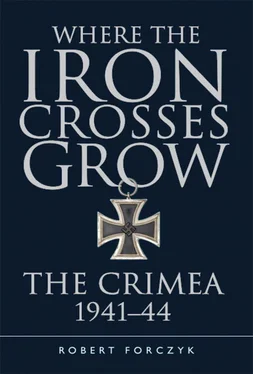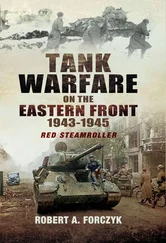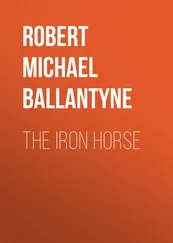On the evening of November 2, soldiers from the II./IR 438 of the 132. Infanterie-Division assaulted Lieutenant Eaika’s Coastal Battery No. 54, which was overrun after a tough fight. It was the first of Sevastopol’s coastal defenses to fall. Despite a punishing Stuka attack that knocked out three of the battery’s four 102mm guns, the German battalion still suffered heavy casualties, including 21 dead. Lieutenant Eaika escaped into the hills to join the partisans while 28 of his men swam out to a Soviet patrol boat. Following this hollow triumph, the 132. Infanterie-Division pushed across the Kacha River with two regiments, including Bidermann’s IR 437, with the 50. Infanterie-Division coming up close behind. While crossing the Kacha, the German infantry came under fire from Lieutenant Mikhail V. Matushenko’s Battery No. 10, which was armed with four 203mm naval guns. Lieutenant Aleksandr’s Battery No. 30 also opened fire with its twin 305mm turrets, which the German infantry found unnerving. Between November 1 and November 4, these two batteries fired 276 203mm and 142 305mm rounds at the troops of the 132. Infanterie-Division. [21] Perechnev and Vinogradov, Na strazhe morskikh gorizontov [ The Guardians of the Coast ], p. 45.
Even more worrisome, small groups from Zhidilov’s 7th Naval Infantry Brigade (7 NIB) that had been bypassed by Ziegler’s Brigade now tried to fight their way through the 132. Infanterie-Division to get to Sevastopol. Gottlob Bidermann recounts how his Panzerjäger platoon, attached to a company from IR 437, was attacked from behind several times by groups of naval infantrymen trying to infiltrate through the German lines; Bidermann also described these naval infantrymen as elite troops and noted that their SVT-40 automatic rifles gave them a firepower advantage over German infantry armed with the bolt-action Kar98k. [22] Bidermann, In Deadly Combat: A German Soldier’s Memoir of the Eastern Front , pp. 50–54.
During November 4–6, Hansen used the 132. Infanterie-Division to methodically begin clearing the Bel’bek River valley around Duvankoi, but ran into increasing resistance from Vilshansky’s 8 NIB, the 17th and 18th Naval Infantry Battalions, and the newly raised 3rd Naval Infantry Regiment. In just two days, the 132. Infanterie-Division suffered 428 casualties – the equivalent of a battalion – in minor skirmishing actions. However, Soviet casualties were much higher among the inexperienced naval units. Hansen was trying to jockey the 50. Infanterie-Division to the southeast, to hit Sevastopol’s defenses from due east, but this left the 132. Infanterie-Division unsupported and with its hands full against a growing assortment of ad hoc Russian units. Ominously, the first elements of Petrov’s Coastal Army had slipped into the defenses around Sevastopol on November 5, further reinforcing the defense. The Soviet 17th Naval Infantry Battalion was encouraged enough to mount a local counterattack that recaptured Duvankoi from IR 438. Sensing that the 132. Infanterie-Division was vulnerable to a spoiling attack, Rear-Admiral Zhukov ordered Vilshansky’s 8 NIB to mount a full-scale counterattack north of Duvankoi at dawn on November 7. [23] Vilshansky, “Na ognyevom rubezhye” [On the Shooting Range] in Petr Ye. Garmash (ed.), Ognennye dni Sevastopolya [Fiery Days of Sevastopol] (Simferopol: Tavria Publishing, 1978), pp. 40–47.
Bidermann’s IR 437 was on the receiving end of Vilshanksy’s counterattack:
Suddenly and silently, from out of the darkness, poured waves of enemy soldiers. Elite troops of the Soviet Naval Infantry massed toward us… They assaulted our positions from the thick underbrush before Makenziya, pouring toward us in dark waves, hoarse shouts of “Urrah!” erupting from the oncoming line… We opened fire with high explosives point-blank into the rows of attackers. [24] Bidermann, In Deadly Combat: A German Soldier’s Memoir of the Eastern Front , p. 57.
Although MG 34 machine-gun fire and 8cm mortar rounds broke up the first Soviet assault, the naval infantrymen attacked in waves that stressed the German defense to its limits. Matushenko’s Battery No. 10 laid down a prepatory barrage that succeeded in destroying some German vehicles, and, after three hours of fighting, Vilshansky’s sailors had seized three hilltop objectives. Vilshansky claimed to have eliminated 250 German soldiers, and Bidermann admitted that his battalion “suffered numerous losses.” However, the Soviet sailors could not hold their hard-won ground and were forced to yield to German counterattacks on November 8. Nevertheless, Vilshansky’s counterattack caused Manstein to realize that LIV Armeekorps was not strong enough to fight its way into Sevastopol with just two divisions, and he ordered Salmuth to transfer the 22. Infanterie-Division to reinforce Hansen’s corps. On the Simferopol–Sevastopol road the German pursuit was now over, and Hansen now had to begin preparing for another deliberate assault, which bought precious time for the defenders.
While Hansen’s corps had been trying to push through directly to Sevastopol, the 72. Infanterie-Division had been pursuing Petrov’s Coastal Army through the Yaila Mountains. Here and there the Soviets turned to fight when the German pursuit grew too arrogant. On November 4, the 95th Rifle Division ambushed Panzerjäger-Abteilung 72 near the village of Ulu-Sala, destroying half its vehicles and most of its Pak guns. A winter storm that brought heavy rain on November 6 further slowed down the German pursuit, and the Coastal Army steadily won the race to Sevastopol. Nevertheless, the 72. Infanterie-Division had to fight its way into Yalta, which was occupied on the morning of November 8, and an advance guard began to march west along the coast road toward Balaklava. Near Baidary on the coast, Lieutenant Aleksandr S. Terletskiy was in charge of a small group of NKVD border guards retreating toward Sevastopol. On November 9, his group moved through the Baydar Gates, an important mountain pass east of Balaklava. In order to delay the pursuing Germans, Terletskiy’s detachment emplaced explosives on a rock overhang over the narrow coast road and then detonated it to block the pass. Terletskiy was later awarded the Hero of the Soviet Union for delaying the 72. Infanterie-Division’s advance along the coast from Yalta, although the impact of his feat on German operations appears to have been minimal. Furthermore, Terletskiy’s group failed to reach Sevastopol and instead joined a partisan group in the mountains east of Balaklava, as did other Soviet troops who became isolated by the German pursuit.
By November 9, the German pursuit across the Crimea was over. Petrov had managed to save 17,000 troops from his Coastal Army, but had lost a good part of his artillery and vehicles. The 25th Rifle Division Chapaevskaya had suffered 50 percent losses and only 4,233 of its troops made it to Sevastopol; two of its three rifle regiments were reduced to fewer than 500 troops. [25] TsAMO f. 288, Op. 9912, 2.
One exception was Colonel Ivan I. Khakhanov’s 52nd Artillery Regiment, which made it to Sevastopol with 13 of their 155mm Schneider Model 1917 howitzers (taken from Poland in 1939). Brigade Ziegler had captured 2,711 prisoners, 52 trucks, and 9 76.2mm guns, while suffering 215 casualties in the pursuit. [26] Ia, VII, Beilagenheft zum Kriegstagebuch Nr. 4, “ Gefechtsbericht der Brigade Ziegler, 28.10 – 7.11.41 ,” XXXXII Armeekorps, NAM (National Archives Microfilm), series T-314, Roll 1669, frame 409.
Nevertheless, the escape of Petrov’s Coastal Army was a minor tactical feat for the Red Army, and a major blow to Manstein’s plans to seize Sevastopol in a swift coup.
____________
While Petrov was trying to organize Sevastopol’s defenses, the remnants of the 51st Army continued to retreat toward Kerch. On the evening of November 3, the 170. Infanterie-Division captured the port of Feodosiya. With the Germans racing across the Crimea and cities falling like nine pins, Communist Party officials and NKVD personnel bolted toward the coast in an effort to save themselves. The Komsomol (Young Communist League) had established Artek camps in the pleasant climate of the Crimea to indoctrinate the next generation of Soviet leaders, and these camps still had thousands of youths stranded by the German invasion; many were the children of party officials who now used their influence to get them evacuated from the Crimea. Everyone who could headed for the ports of Yalta and Alushta, which had not yet fallen.
Читать дальше












